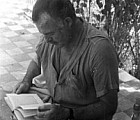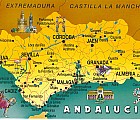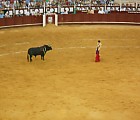Bullfighting, Hemingway, and history from a Spanish Perspective

I heard enthusiastic reports about Paco Pereda and his ideas about bullfighting long before I thought to interview him. Paco was my son’s professor at the University of the Basque Country in San Sebastian, Spain. Paco is an energetic, funny and fascinating teacher, whose lectures on Spanish culture and history, I’ve been told, are unforgettable.
Thank you to Joseph Grant and Peter Krynicki for writing the questions about For Whom the Bell Tolls and the Spanish Civil War. And a huge thank you to Matthew Simpson who translated all of this twice, once from English to Spanish and then back again. Thank you to Paco for an informative and entertaining interview.
More interesting people will be appearing here soon and more Hadley audio will be up on the weekend of June 12th.
 Paco Pereda was born in San Sebastían, Spain in 1958. He studied education and philosophy in university, with a focus on the philosophy of cultural anthropology. He carried out his field work in Morocco. He teaches at the University of the Basque Country in San Sebastían. Since 1992, he has been teaching Spanish history and culture to American college students who study abroad in Spain.
Paco Pereda was born in San Sebastían, Spain in 1958. He studied education and philosophy in university, with a focus on the philosophy of cultural anthropology. He carried out his field work in Morocco. He teaches at the University of the Basque Country in San Sebastían. Since 1992, he has been teaching Spanish history and culture to American college students who study abroad in Spain.
AB: Paco, can you tell me a little bit about the Spanish personality?
PP: I don’t think a Spanish personality actually exists, nor any other kind of national character. All countries contain a variety of subcultures within them that react to the world in their unique way. Sometimes these can function well together and other times they clash.
AB: How is the Basque country different from the rest of Spain?
PP: Basque culture overlaps with Spanish and French culture, respectively, in many ways, but it has its differences too. These differences often lead to clashes from which conflict arises. The question is: is it possible to be Basque while living in the Spanish nation? Sometimes the answer is “no”. For instance, Basque nationalists propose seceding from Spain and France to form their own independent Basque nation. The nationalists tend to exaggerate the existing conflicts or even invent new ones to emphasize the cultural differences of the situation. On the other hand, there are Spanish nationalists as well, who have a very narrow view of what it means to be Spanish. They will confuse Castilla or Andalucia with Spain itself, forgetting the diversity of climates, languages, and economies in the different regions. They’ve held onto the values of Franco’s Spain, which completely excludes diversity. The conflict between the Basques and the Spanish and French is really fueled by nationalists on each side.
AB: Can you speak about the Spanish outlook on E.T.A.?
PP: The Spanish attitude regarding E.T.A. is, as you would expect, contrary to its political objectives and methods of doing things. On the other side, the feelings of the Basques are mixed. For the majority of older generations, E.T.A. started as a group that fought for their liberties against Franco’s repressive regime. But Franquismo (AB: referring to the political system and culture of oppression created by Franco during his 36 year tenure as dictator of Spain) was ousted a long time ago (AB: he died in 1975 and democratic institutions slowly regained their place over the next decade). For years E.T.A. kept the sentimental approval of the Basque people, but it lost its support and eventually was rejected outright as Franquisimo (or Francoism) continued to fade into the distance of the past.
AB: How and when did bullfighting start?
PP: Bullfighting traces its origins all the way back to the prehistoric hunt and ancient rites of passage for young men. Different games and traditions evolved over time and according to geographical differences, passing through classical Greece, the Roman coliseums, and medieval tournaments. Bullfighting now takes many forms: the running of the bulls, bull leaping, the Red Heifer sacrifices, the French-Landesa bull runs, among others.

AB: It is hard for Americans to understand the meaning of bullfighting. Can you explain what bullfighting means to the bullfighter and to the spectators?
PP: Yes, it’s difficult for Americans to understand the meaning of bullfighting, but keep in mind that it’s also hard for the Spanish! For most Americans, Hemingway has been a good introduction to bullfighting, but at the same time, this has been problematic. Hemingway likes to exaggerate. He takes Spanish culture to be one huge party. Yes, there are great parties and immense enthusiasm during the bullfights, but the Spanish understand that it’s just an event. It’s not our real life. Well, the natives also tend to exaggerate; it’s normal for people to exaggerate about something they are famous for. The bullfighting situation is really not much different than the way people party and celebrate important sporting events all over the world. There is terrific enthusiasm during the event, but it’s still just a game.
The meaning of bullfighting is open to interpretation (as long as the bull is strong and the bullfighter knows what he is doing). The spectator has flashes of intuition that come about from the sheer emotionality of the event. These small flashes open the door to seeing different meanings, to nuances, to another sensibility. Later, from intuition, we usually try to create theories. But the theory is never true. It is just a possibility that we verbalize, just one interpretation that expands our comprehension. There is no “one truth”. It’s more like a dream: we have small images and feelings, but as we try to articulate them, they become foggy or disappear. Bullfighting is an ephemeral art and its meaning is also fleeting. Theories attempt to rationalize it and hold on to a meaning, but the truth of it always escapes us.
AB: My son says you have an almost Freudian interpretation of bullfighting. Can you explain?
PP: I don’t have special faith in one theory or the other; they are just tools that can help us. What happens with the bulls is what happens with classical art: someone is always proposing a new argument or thesis. None ever stick, though. The meaning remains open to interpretation and speculation. Like the effect of a mirror, when we seek to explain bullfighting we are really explaining ourselves, how we think, how we feel.
The process of interpreting is an interesting one. We really have to dig out our own subconscious. As the American anthropologist C. Geertz said, we encounter a “dark clarity” or a “clear darkness”. If we over explain things, we kill intuition. When we put too much light on some truth we suddenly grasp, it ceases to be true. We need a dark obscurity to keep on feeding emotions, to keep the function of the theatrical alive in our lives.
Everything centers around the bull and the bullfighter. The bull can represent anything we choose: the unknown, the “other”, fear, money, sex, work, romantic relationships, etc. It is something that you have to see to understand. The most important thing isn’t in just killing the bull, but in how one kills it. And it’s the same with human experience. The most profound thing is how we live out our conflicts and problems.
The Freudian interpretation maintains that in the relationship between the bull and the bullfighter we come upon the fundamental polarities of human existence. Blind animal instinct comes up against strategy and intelligence, which together is human nature. The bullfighter has to overcome his own animal nature, his own impulse to escape danger and run. So he fights, swoops the cape, adds a personal aesthetic, portrays an intelligence and bravery we hadn’t seen before. And, most importantly, he must make the bull “dance” to his rhythm. The bull isn’t an easy opponent, obviously. Their confrontation has 3 distinct acts. In each act, there are long-established rules that the bullfighter must carry out. From there, it’s about being an artist. He must understand when it’s necessary to be gentle and patient and when it’s necessary to be bold and aggressive. The style defines the bullfighter.
The problems in life are a lot like the bull: sudden, immense, frightening, coming at us blindly. The way we handle our problems is similar to the strategy and intelligence with which the bullfighter controls the bull. So, we actually find a whole mode of being with bullfighting, which is being smooth yet at the same time ruling with an iron hand.
More fundamental opposites that we see in bullfighting are the following:
– the masculine against the feminine (but not man against woman)
– poverty against wealth
– the individual against society, which is also a rite of passage as the bullfighter performs before his friends, family, and the cultural institutions which have brought him up
There is more psychoanalytic symbolism as well:
– on the religious level, the punctured and bleeding bull can symbolize Jesus Christ who suffers and bleeds on the cross
– in terms of sexuality, the effeminate costume the bullfighter wears represents the feminine; the penetration by spears and the subsequent wounding of the bull represent the moment when the bull and bullfighter reverse roles of male and female sexuality, with the bull “bleeding” and the bullfighter becoming the aggressor; at the climatic act of the killing of the bull, the sword functions as the male phallus which penetrates the bull’s neck.
More than anything, these interpretations are tools for helping us understand our own emotions.
AB: How has bullfighting changed and transformed throughout the ages?
PP: This is the question I find most fascinating. Over the last 100 years ago bullfighting has gone from a popular spectacle followed with devotion to something steeped in controversy and unacceptable to about half the population. Bullfighting has always belonged to the rural world, the conservative and the traditional peoples, the upper classes. Today Spanish society is complex, divided, postmodern, and highly urbanized. Its liberal values repudiate the mentality of risking death and bloody struggle which bullfighting is about. Bullfighting survives today thanks to the traditional sector of society and the tourists. (Hemingway has played a big role in this). Tourists come here in search of a traditional Spain that no longer exists but is prepared for them with nostalgia.
AB: What is the future of bullfighting?
PP: The primary enemies of bullfighting aren’t the environmentalists or pro animal rights activists. The primary enemy is the mediocrity and boredom of today’s bullfighters which result from their lack of imagination and risk. The plazas are emptying because of the shallow commercial vision and bland performances of the bullfighters and the easy bulls they fight.
AB: How is the bullfighting scene different in Madrid, Pamplona, Valencia, etc…?
PB: Each region has its own personality and demands different things: dangerous bulls, decorative style, parties, seriousness, etc.
AB: As a Spanish historian, do you think that Hemingway’s portrayal in For Whom the Bell Tollsor what could be categorized as an American view of the Spanish Civil War, is an accurate one?
PP: His point of view was that of a foreign journalist, but I think he basically understood what was happening.
AB: Can you talk about the killing of Lorca. What happened? Why was he killed?
PP: Hateful and violent intolerance of difference. (AB: Lorca was a homosexual as well as a threatening literary voice.)
AB: In the entire world, no one would suggest that we simply forget about slavery and the buying and selling of people, the Middle passage, the Holocaust, etc. . . . But in Spain there is something called (in Spanish) The Great forgetting, or simply, the forgetting. It has to do with the Spanish civil War, Franco, and the atrocities both during the war and afterward, and seems to suggest that the whole thing was an aberration and best forgotten. Is it best to just forget? If so, why? In not, why?
PP: Nothing is ever forgotten in Spain. We have a reoccurring problem in our country: the coming-to-power of a regime of terror and the subsequent genocide against its political opposition. No one has asked for forgiveness, even to this day. Now in the spring of 2010 we have the problem again as certain conservative groups justify the coup d’état and the rebellion against the government and Parliament.
AB: Are there still resentments between people about the Spanish Civil War? After all, neighbors were killing neighbors.
PP: Yes, people have a certain respect about not bringing up the past. But several ultra-conservative post-Franquista groups, political professionals, journalists, and other authors elude this responsibility and attack the respect of millions of people.

AB: While growing up with Franco as Head of State and given Hemingway’s pro-Republican political views, was For Whom the Bell Tolls ever banned?
PP: For Whom the Bell Tolls became a fairly popular film during Franco’s dictatorship, but it was censured and had parts removed or manipulated in order to portray a simple love story. The political content was taken out completely. After Franquismo (Franco’s reign), when it was possible to see the uncensored version, other films came out that talked about what happened in during the Civil War more directly, so it was eventually lost to time.
There was a curious relationship between some American film-makers and the Spanish film industry who came to visit during Franco’s time. Another author, Orson Wells, wrote about Spain as a land of passion and adventure. All these had their origins in Hemingway. Hemingway was the first one to create an image of Spain which Americans have come looking for and which is, ironically, quite different from the Spanish opinion of Spain. The literary vision Americans had made the Spanish out to be a romantic and passionate people, which they themselves didn’t believe.
Hemingway is an ambiguous character in Spanish history because he was more or less well liked by both the Republicans and the Fascists. It was his political beliefs that did it for the Republicans and the fact that he liked bullfighting, drinking, hunting, and powerful emotions (pleased) for the Fascists. So he’s never had a clear identity or point of reference. For the most part, he’s looked at affectionately today, but it’s understood that he had a patronizing outlook on Spain. Where he saw heroism and the glorious cause, the Spanish saw hunger and the struggle for survival.
AB: Tierra de España (Spanish Earth) is a feature-film length documentary film narrated by Hemingway regarding the fighting between the army of General Francisco Franco and the Republican Government troops near Madrid in 1937. What is your impression of this film? How is the film regarded in your country??
PP: “Spanish Land”. I saw the film just one time and that was a long time ago so I can’t give my opinion. At any rate, it’s not very well known in Spain. Like with a lot of other films during the dictatorship, it was banned, but even after the dictatorship ended it didn’t generate very much interest because there were other films that presented a much more explicit history.
Each author captures part of the situation, but there is a personal aspect, as well, where he projects the themes and ideas that are important to him. Many times it is the reaction that the situation produces in him that he writes about. It isn’t something to be taken as an objective documentary since he had already had those points of views and ideas inside him before the situation occurred. Someone who is inclined to defend the weak will always be sensitive to injustices while another person might not even notice that they exist. To place oneself in dramatic situations is a sure route to self-knowledge, to discovery of what kind of things are important in one’s life. This ties in with bullfighting: the spectator (the public) watches the bullfight and discovers his own unconscious problems. Hemingway, with bullfighting and the Civil War and Spain itself – I think he understood this kind of revelation.






As I read the interview sipping on my Sangre de Toro, a favorite red wine from the Catalunya region of Spain, I was amazed at the scope of information provided by Señor Pereda’s excellent interview. It is another win for Allie Baker, too! In reading it, it is no wonder his lectures are legendary. The questions (no, not my questions)and answers were wonderful on so many levels and this will be an interview to read over and over. Excellence, pure and simple.
With Hemingway there always seems to be a blurring of masculine/feminine roles.
Interesting how the the bullfight, (the matador’s costume,and the killing of the bull, for example), is analysed by Mr. Perada.
“The Forgetting” is also a fascinating phenomenon – but perhaps not too different from our own Civil War.
You just keep hitting them out of the park. I really enjoyed this interview. The philosophy behind bullfighting seemed to echo Hemingway’s struggles in his early life if not throughout his life.
I too will be reading this one more than once.
This is the most interesting interview. It saddens me that nothing stays the same but at the same time nothing changes. Viva La Espana!
Wonderful interview ! Where do you find these people ?
Your questions and Mr Pereda’s comments were brilliant ! Thanks for doing what you do so well Allie.
Wonderful! Pereda’s insight into human nature provides a beautiful understanding of the desire to fulfill the expectations of others while remaining true to ourselves – always questioning. Kudos to your translator. The sincerity and honesty of Pereda’s words were not lost. I look forward to sharing in your next insightful Hemingway experience.
This is much more compelling than your run-of-the-mill Hemingway bullfighting article. Paco Pereda is one hell of an interesting guy. Great work here.
Pacisimo! My best *Ever* teacher and I am a teacher. Thanks for the reminder of his intelligence. Echo de menos las clases de Paco!
Ginna, I love this interview too! Paco is a very interesting person and I hope to feature him here again. Thank you for your comment –
Allie
Excellent site you’ve got here.. It’s hard to find high quality writing like yours these days. I really appreciate individuals like you! Take care!!|
This piece of writing is genuinely a pleasant one it helps new internet people, who are wishing in favor of blogging.|